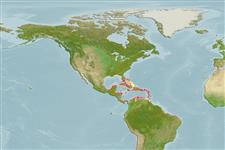Common names from other countries
>
Gobiiformes (Gobies) >
Eleotridae (Bully sleepers)
Etymology: Gobiomorus: Latin, gobius = gudgeon + Greek, moros = silly, stupid (Ref. 45335).
More on author: Lacepède.
Environment: milieu / climate zone / depth range / distribution range
Ecologia
marino; acqua dolce; salmastro demersale; amfidromo (Ref. 46888). Tropical; 22°C - 29°C (Ref. 36880); 33°N - 5°S, 98°W - 35°W (Ref. 117424)
Western Central Atlantic: Southern Florida and southern Texas in USA to eastern Brazil. Eastern Central Atlantic: Macias Nguema (Fernando Po).
Size / Peso / Age
Maturity: Lm ? range ? - ? cm
Max length : 90.0 cm TL maschio/sesso non determinato; (Ref. 11344); common length : 36.0 cm TL maschio/sesso non determinato; (Ref. 12193); peso massimo pubblicato: 7.5 kg (Ref. 11344)
Spine dorsali (totale) : 7; Raggi dorsali molli (totale) : 9; Spine anali: 1; Raggi anali molli: 9.
Adults occur in fresh water, often well inland. Found over sand streams, usually in current near cover (Ref. 86798). Inhabits larger free flowing clear water streams (Ref. 11225). They lie mostly on the bottom in slower moving part of streams, sometimes on logs or large stones and on leaf debris or gravel (Ref. 11225). A carnivorous and benthic fish that relies on its sluggish behavior and cryptic coloration (Ref. 36880). Feeds on all greater invertebrates and regularly also fish (Ref. 92840).
Life cycle and mating behavior
Maturities | Riproduzione | Spawnings | Egg(s) | Fecundities | Larve
Robins, C.R. and G.C. Ray, 1986. A field guide to Atlantic coast fishes of North America. Houghton Mifflin Company, Boston, U.S.A. 354 p. (Ref. 7251)
IUCN Red List Status (Ref. 130435)
CITES (Ref. 128078)
Not Evaluated
Threat to humans
Harmless
Human uses
Strumenti
Special reports
Download XML
Fonti Internet
Estimates based on models
Preferred temperature (Ref.
115969): 26.4 - 28.3, mean 27.5 (based on 395 cells).
Phylogenetic diversity index (Ref.
82804): PD
50 = 0.6250 [Uniqueness, from 0.5 = low to 2.0 = high].
Bayesian length-weight: a=0.01023 (0.00391 - 0.02676), b=3.02 (2.79 - 3.25), in cm Total Length, based on LWR estimates for this (Sub)family-body shape (Ref.
93245).
Trophic level (Ref.
69278): 3.6 ±0.57 se; based on food items.
Resilienza (Ref.
120179): Molto basso, tempo minimo di raddoppiamento della popolazione più di 14 anni (Preliminary K or Fecundity.).
Fishing Vulnerability (Ref.
59153): High vulnerability (56 of 100).
